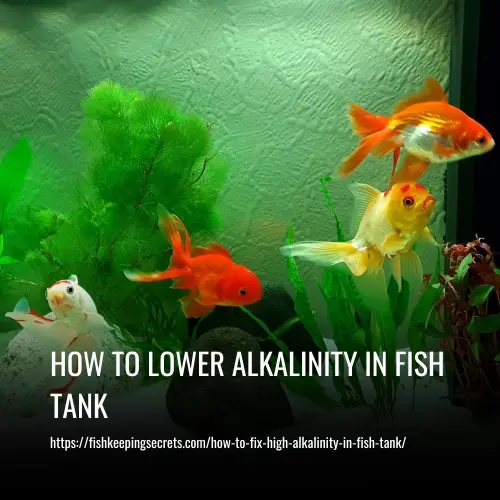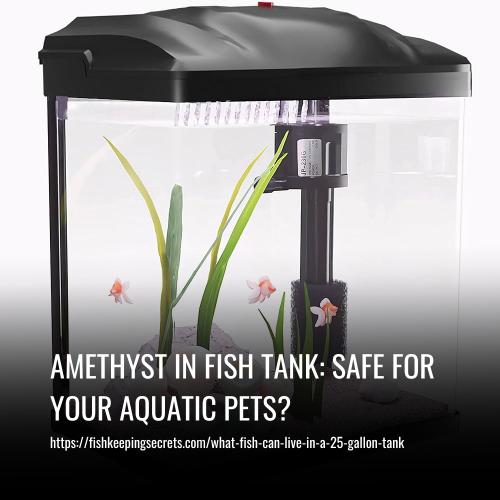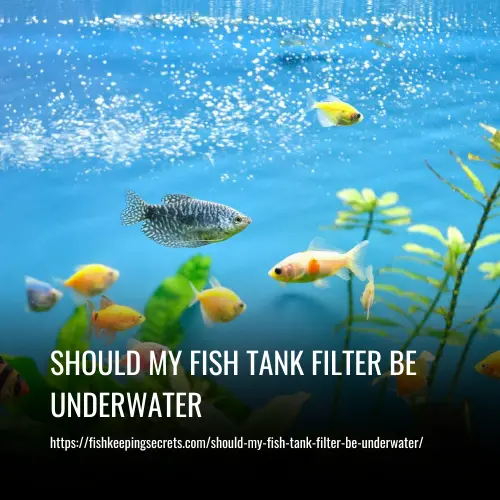To remove calcium buildup on a fish tank, use a mixture of vinegar and water and scrub with a non-abrasive sponge. Calcium buildup on a fish tank can be unsightly and harmful to aquatic life.
It can also affect the clarity of the water and make it difficult to properly maintain the tank. Fortunately, removing calcium buildup is a simple task that any fish tank owner can do. Vinegar and water mixture is an effective solution for dissolving the calcium and can be used with a non-abrasive sponge to scrub away any buildup.
It’s important to avoid using any abrasive materials or harsh chemicals that could harm the tank or its inhabitants. With a little bit of effort, you can have a clean and healthy fish tank once again.

What Is Calcium Buildup And Why Does It Occur in Fish Tank?
Calcium buildup in a fish tank refers to the accumulation of calcium deposits on the glass or other surfaces inside the tank. These deposits often appear as white, crusty, or chalky formations and can be quite stubborn to remove.
Understanding The Concept Of Calcium Buildup In Fish Tank
Calcium buildup is a common issue in fish tanks and happens when the minerals present in water are deposited onto the tank’s interior surfaces. It typically manifests as white or grayish spots on the glass or acrylic surface of the tank, and if it goes unaddressed, it can negatively impact your fish.
Understanding the basics behind calcium buildup is essential in preventing it from happening and keeping your fish happy and healthy. Here are some key points to remember:
- Calcium buildup comprises mineral deposits of calcium and magnesium on the walls of your tank.
- Minerals like calcium are present in varying concentrations in most tap water sources.
- Calcium buildup can be accelerated by factors like high ph levels, evaporation, and hard water.
Causes Of Calcium Buildup
Several factors can catalyze calcium buildup in fish tanks. Understanding what factors could contribute to this phenomenon is key to preventing it from happening in the first place. Here are some common causes of calcium buildup in fish tanks that you should know:
- High ph levels: The ph levels over 7.2 can cause deposits of calcium and other minerals that are dissolved in the water.
- Evaporation: As water evaporates, it leaves behind minerals that accumulate over time, especially if you don’t refill the tank regularly.
- Hard water: Hard water is when the water supply has a high concentration of minerals like calcium and magnesium. These minerals are available in hard water and could invariably cause buildup in the tank over time.
Impact Of Calcium Buildup On Fish Health
Calcium buildup in a fish tank can have negative effects on fish health quickly, if not addressed properly. If the buildup is severe and extensive, it can even cause fish death. Here are some ways calcium buildup affects fish health that every aquarium owner should be aware of:
- Reduces oxygen levels: As the minerals in the water accumulate, they can reduce the availability of oxygen in the water, which can be detrimental to the health of your fish.
- Weakens the immune system: Calcium buildup leads to the growth of bacterial colonies, affecting the ph balance in the tank and the immunity of the fish. As a result, your fish may become sick more frequently.
- Impairs sight: Calcium buildup can cause cloudy or blurry spots on the surface of the fish tank, making it difficult for your fish to see and stressful for them.
Identifying the causes of calcium buildup, understanding what it is, and how it can affect fish health is essential to maintaining a healthy environment for your fish. Addressing calcium buildup regularly, before it becomes a problem, is key to keeping your fish healthy and happy.
Signs Of Calcium Buildup In Fish Tank
Calcium buildup in fish tanks is a common problem that aquarium owners face. It occurs due to the presence of hard water minerals, mainly calcium carbonate, in the water used to fill the tank. It is essential to identify the signs of calcium buildup in fish tanks to prevent the fish from getting sick or even dying.
Physical Signs
- White or grayish residue on the tank walls, decor, and equipment.
- Rough or grainy texture on tank surfaces.
- Cloudy, milky, or hazy appearance of the water.
Behavioral Signs
- Fish gasping for air at the surface of the water due to a lack of oxygen in the high ph level of the water.
- Fish flashing or rubbing themselves against tank surfaces due to skin irritation.
- Decreased movement or appetite in fish due to stressful living conditions.
Water Chemistry Testing
It is crucial to test the water chemistry regularly to determine if there is a calcium buildup in the fish tank. Use a reliable water testing kit to check the ph, carbonate hardness (kh), and general hardness (gh) levels in the aquarium water.
The ideal ph level for most freshwater fish is between 6. 5-7. 5, while the kh and gh levels should remain between 3-10 dkh and 6-16 dgh, respectively.
To sum it up, calcium buildup in fish tanks can lead to several health concerns for fish. Identifying the physical and behavioral signs of calcium buildup and testing the water chemistry regularly can prevent these issues, ensuring a healthy, happy aquarium for you and your fish.
Easy Removal Steps Of Calcium Buildup
Removing calcium buildup from your fish tank is essential for maintaining a healthy environment for your fish. Here are some easy steps to remove calcium buildup:
Equipment Required
Before starting the process of removing calcium buildup from your fish tank, you need to gather the necessary equipment. Here’s what you need:
- Plastic scraper or a razor blade
- White vinegar
- Warm water
- Soft-bristled brush
- Towels or paper towels
- Gloves (optional)
Step-By-Step Process To Remove Calcium Buildup
Do you want to know how to safely remove calcium buildup from your fish tank? Follow these simple steps:
- Remove the fish and decorations from the tank and drain the aquarium water completely.
- Use a plastic scraper or razor blade to gently scrape off the calcium buildup from the sides and bottom of the fish tank.
- Mix equal parts of white vinegar and warm water. Soak a soft-bristled brush in the solution and gently scrub the inside of the tank. Avoid using abrasive brushes, as they can scratch the glass.
- Rinse the tank thoroughly with warm water to remove any residual vinegar.
- Dry the inside of the tank with a towel or paper towel.
Preventative Measures To Avoid Calcium Buildup In the Future
Prevention is always better than cure, so here are some tips to prevent calcium buildup in your fish tank:
- Avoid using hard water for your fish tank. Hard water contains high levels of minerals that can lead to calcium buildup.
- Use a water softener to reduce the hardness of the water before filling the tank.
- Clean the tank regularly to prevent the buildup of algae and other minerals.
- Use a calcium reactor or a reverse osmosis (ro) system to filter the water and remove excess minerals.
- Consider adding plants or moss to the tank, as they can help absorb excess minerals and provide a natural filtration system.
Keeping these tips in mind, you can prevent calcium buildup in the future and keep your fish tank clean and healthy.
Tips And Tricks To Maintain A Healthy Fish Tank
In addition to preventing calcium buildup, there are several other tips and tricks you can follow to maintain a healthy fish tank:
1. Proper Filtration System:
Maintaining a proper filtration system is crucial in keeping your fish tank clean and healthy. Here are some key points to keep in mind to ensure your filtration system is functioning correctly:
- Clean your filter regularly: Regularly clean your filter to prevent clogging and ensure good water flow.
- Check the water flow: Check the water flow of the filter to make sure that it is sufficient for the size of your tank and the number of fish in it.
- Replace filter media: Replace the filter media regularly to ensure that it is working efficiently.
- Use the right type of filter: Choose the right type of filter for your tank. Different types of filters work better for different types of tanks.
2. Regular Water Changes And Cleaning Schedule:
In addition to having a good filtration system, regular water changes and cleaning schedules are essential for maintaining a healthy fish tank. Here are some tips to help you keep up with the maintenance:
- Test the water regularly: Test your water at least once a week to ensure that it is in good condition for your fish.
- Replace a portion of the water regularly: Change a portion of the water in your tank regularly. The recommended amount is usually around 25% to 30% every two weeks.
- Clean the aquarium glass: Clean the aquarium glass regularly to ensure maximum visibility for your fish.
- Clean accessories: Clean accessories such as heaters, thermometers, and filters, can accumulate debris and grime over time.
3. Importance Of Testing Water Chemistry:
Testing your water chemistry is critical to keeping your fish tank clean and healthy. Here are some key points to keep in mind when testing your water:
- Test for ammonia, nitrite, and nitrate: Testing for these three chemicals is critical to ensure a healthy environment for your fish.
- Maintain pH levels: Test your water’s pH levels regularly and ensure that it stays between 6.5 and 7.5 for freshwater fish.
- Test for water hardness: Many freshwater fish require a specific level of water hardness, so it’s important to test your water’s hardness and adjust it as needed.
- Purchase a high-quality water test kit: Invest in a high-quality water test kit to ensure that you get accurate results.
4. Feeding Schedule And Nutrition For The Fish:
Feeding your fish a balanced diet is essential to keeping them healthy. Here are some tips to ensure your fish get the proper nutrition:
- Determine appropriate feeding amounts: In general, feed your fish only the amount of food that they will consume in two to three minutes.
- Choose the right type of food: Choose food appropriate for the type of fish and their dietary needs. Some fish are herbivores, while others are carnivores.
- Avoid overfeeding: Overfeeding can lead to uneaten food, which can cause water to become cloudy and lead to other issues.
- Provide variety: Provide a variety of food to give your fish a well-rounded diet. Pellets and flakes are often fortified with vitamins and minerals that your fish needs. You can also feed them frozen or live foods for a treat.
Keeping a fish tank clean and healthy requires diligence and attention to detail. By following these additional tips and tricks, you can ensure that your aquarium provides a safe and healthy environment for your fish to thrive.
FAQs.
Calcium buildup is often a result of hard water and high pH levels. It can also be caused by the presence of certain types of rocks, decorations, or food waste. The buildup can harm your fish and damage the tank, so it’s important to take steps to remove it.
To prevent calcium buildup, use water softeners or purifiers to remove excess minerals and maintain a stable ph level. Be mindful of the type of rocks, shells, and decorations you place in the tank, as well as the type of fish food you use.
Not removing calcium buildup can lead to serious health issues for your fish, as well as damage to the tank. Stressed fish become more vulnerable to diseases and can have difficulty swimming, eating, and breeding. The buildup can also cause blockages in-tank filters and pumps, leading to equipment failure.
To remove calcium buildup, you will need vinegar or lemon juice, a sponge or scrub brush, and a plastic scraper or putty knife. Avoid using anything too abrasive, as it can scratch the tank’s glass or acrylic surface.
First, unplug any electrical equipment and remove your fish. Next, mix vinegar or lemon juice with water and apply it to the affected areas. Wait a few minutes for the solution to work and then scrub the area with a sponge or brush.
Use a plastic scraper or putty knife to remove any stubborn buildup. Finally, rinse the area thoroughly with clean water before returning your fish to the tank.
Conclusion
After going through various ways on how to remove calcium buildup from fish tanks, we can say that it is an easy-to-handle process that does not take much of your time. Regular maintenance is key to a healthy and clean aquarium, and removing calcium buildup is just as important as cleaning the filters or replacing water.
Thankfully, using household items such as vinegar and baking soda or commercial products specifically designed for fish tanks, can easily help removing the unwanted calcium from your fish tank. Remember to use soft sponges or rags to avoid scratching the aquarium glass.



